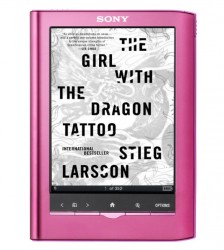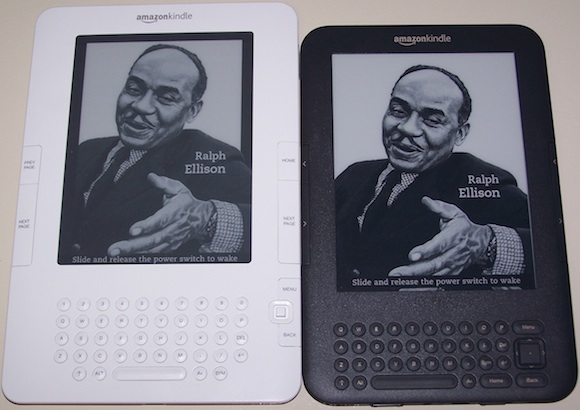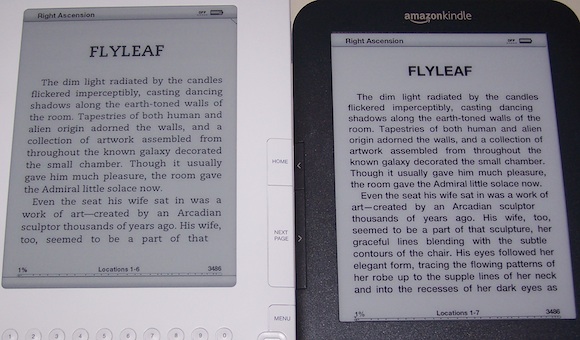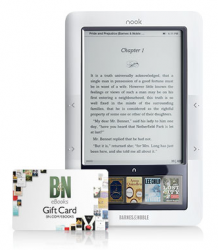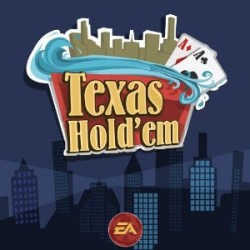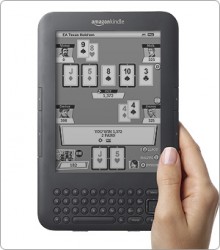So, you just got a Kindle? Looking for set-up instructions, trying to figure out how to get e-books on your Kindle, or just want some Kindle tips and tricks? With this Beginner’s Guide to the Kindle, I’ll do my best to give you a starter course:
Preparing For Your Soon-To-Arrive Kindle
After you click the “Buy Now” button for your new Kindle, while you’re waiting for it to be delivered, you can already start buying or downloading e-books from Amazon in preparation, and start reading them as soon as it arrives. If you bought the Kindle for yourself, it will show up already registered to your Amazon account, and you can start downloading any e-books you bought from Amazon right away. (If you’re receiving the Kindle as a gift, it’s a quick process to register it once it arrives.)
If you prefer to get e-books from other sources in addition to Amazon (for example, Project Gutenberg has thousands of free, public-domain classic e-books), and if you’re the type of person who likes to organize and back up all your computer files, you may want to consider downloading the free program Calibre. With Calibre, you can manage your e-book library, convert e-books from various formats, back e-books up on your computer, and transfer them to your Kindle.
Another place you can find e-books for your new Kindle? Right here — just use the links on the sidebar to the right, or click the tabs at the top of the page for more info on my novels, which are just $2.99 each. When you buy e-books from my website, I’ll happily send them to you in Kindle format (or any other format you request).
Kindle 3 Initial Set-Up
So, your new Kindle 3 just arrived in the mail, what now? When you take it out of the box, you’ll notice what appears to be a sticker on the screen instructing you to use the USB cable that came with your Kindle and plug it into your computer (or into a wall outlet with the included adapter) to charge. What took me a moment to realize when I first saw it is that it’s not a sticker: that message is displayed on the e-Ink screen, which takes zero power to display that message — so the Kindle could sit in its box for months, happily showing that image and waiting to be opened. E-Ink screens, unlike LCD screens, only require power to change the image — you could take the battery out and whatever is showing on your screen would stay in place.
So, once you plug your Kindle in and let it charge, what can you do? First, let’s quickly look at the buttons on the Kindle:

The Kindle 3 displaying a menu from within a book (note the "Menu" button on the upper-right corner of the keyboard below the screen)
On the left and right of the screen are long buttons marked with arrows, the “next page” and “previous page” buttons. Below the screen is a full keyboard, used for typing notes, names of folders (called “collections”), website URLs, etc. To the right is a 5-way controller (arrows for up, down, left, and right surrounding a center button). Near that are “Home,” “Menu,” and “Back” buttons. Also of note is the “Sym” key, used to type numbers and symbols, and the “Aa” key, used to change the text font and size, change the screen orientation, and use text-to-speech. At the bottom of the Kindle, from left to right, are a volume button, a headphone jack, the micro-USB charging port, and the power slider. (Note that the K2’s buttons are in different places, but generally do the same things.)
When you first get your Kindle, slide the power switch to the right and release it to turn your Kindle on (sliding it again puts it to sleep, and holding it to the right for several seconds restarts it). Press the Menu button and use the 5-way controller to select the “Settings” option (your current selection in the menu will be underlined). Press in on the center button of the 5-way controller to activate your selection. The Settings screen will come up, and you will see “Registration,” “Device Name,” “Wi-Fi Settings,” and other options (at the bottom, it will say “Page 1 of 3,” use the previous page and next page buttons to see the rest). The word “register” should be underlined. If you haven’t registered it yet, press the center 5-way button again, and enter the email address and password associated with your Amazon account.
Once your device is registered, you can change your Kindle’s name, connect to a Wi-Fi hotspot (on the Kindle 3; the Kindle 1, 2, and DX only have 3G connectivity), set a password, and change other options. Press the “Home” button when you’re finished.
This will take you to the home screen, where you’ll see a list of all the books on your device, as well as an entry for “Archived Items,” and any collections you may have. Use the previous page and next page buttons if you have more books than fit on the screen at once. Use the 5-way controller to select books and open them. If you’ve purchased books from Amazon, they should download to your device if the 3G or Wi-Fi wireless is turned on — if not, press the Menu key and select “Sync & Check for Items.” In that menu, you will also see an option to “Turn Wireless On (or Off)” (turning it off when not needed — like when reading a book — saves a lot of battery life), “Shop in Kindle Store” (which lets you browse and buy e-books from Amazon straight from your Kindle when wireless is turned on), and “Experimental” (which is where you can access the Web Browser, MP3 player, and text-to-speech function).
Getting Books Onto The Kindle
You’ll want something to read. As mentioned above, any books you purchased from Amazon can be downloaded by selecting “Sync & Check For Items” when you have wireless access. You can also use Calibre (mentioned above), or simply drag & drop e-books you have on your computer. If, for example, you’ve downloaded some free e-books from Project Gutenberg and want to put them on your Kindle, just use the USB cable that came with your Kindle and attach it to your computer. It will show up just like a USB flash drive or external hard drive that you’ve attached to your computer, and will be called “Kindle.” If you double-click to open it, you will see folders, including one named “documents.” Simply drag any e-books (in the appropriate format, like .PRC or MOBI) into the documents folder and eject your Kindle — your new books will show up on your home screen. The Kindle 3 comes with 4 GB of memory — plenty for several thousand e-books. The Kindle 2’s 2 GB should be plenty as well.
Reading And Organizing E-Books
Once you have the e-books you want on your Kindle, return to your Kindle’s home screen (slide the slider if your Kindle has gone to sleep, and press the Home button if necessary). You’ll see a list of all your e-book titles, along with “Archived Items” and probably a dictionary or two (which you could — but wouldn’t normally — read like a book; they’re used for the Kindle’s built-in dictionary look-up feature). At a minimum, you should see a Kindle User’s Guide and a Welcome Note. You can use the previous page and next page buttons if you have more e-books than can fit on a single screen.
If you press the Menu button, you’ll have the option to “Create New Collection,” which is like a folder, or a tag for a book. You can organize your e-books by making collections (“Science Fiction,” “Romance,” “Read,” “Favorites,” etc.). You can then select those collections and press the center 5-way button to open them, or press to the right on the 5-way controller, where you can open, rename, or delete your collections, or add e-books to them.
Similarly, you can select an e-book from the home screen and press the 5-way to the right to see options about that book (“Add to Collection,” “Go to Last Page Read,” “Go to Beginning,” “Search This Document,” etc.). You can press the 5-way to the left to remove the book from the device — for books purchased through Amazon, this will send them to the “Archives,” where Amazon backs them up for you. You can re-download them whenever you have wireless access by going to your “Archived Items.” For books you have “side-loaded” through your computer with the USB cable, it will delete them from the Kindle and Amazon won’t back them up.
At the very top of the home screen will be a bar that shows the name of your Kindle in the upper left, and the wireless status (bars for 3G, Wi-Fi, or “OFF”) and battery life indicator in the upper right. Just below this bar, it will say “Showing all 35 items” (or however many you have on your device), and “By Collections.” Press up to select this line, and press to the right if you’d like to sort by “Most Recent First,” “Title,” “Author,” or “Collections.”
Back on the home screen, use the 5-way controller to select one of the e-books on your device (the “Kindle User’s Guide” will work), and depress the center button to open the e-book.
The e-book will open on your device, and you’ll see the bar at the top, this time with the name of the book in the upper left. At the bottom is the location bar, which shows you your place in an e-book visually, by percentage, and by “locations.” Since you can change the text size and other aspects of an e-book, there are no fixed “pages” like in a printed book, so “locations” are used to track your progress in a book instead (as a rough guideline, about 15 locations would correspond to the average printed book page, so a decent-sized e-book novel would have 2,500 – 7,500 locations).
The screen will show the text of the e-book, bringing you back to the last spot you’ve read, or perhaps the e-book’s cover or a table of contents (if it has them) if it’s your first time opening that particular e-book. To navigate through the book, use the next page and previous page buttons on either side of the screen. The bar at the bottom will show your progress, and, in a nice touch, the bar at the top disappears to provide more room for text. (Press the Menu button to bring back the bar, along with a clock.)
Another method for navigation is to press the Menu button, and one option will be “Go to…” Select this, and you can either type in a particular location number then press the 5-way down to select “location,” or use the 5-way to select “cover,” “beginning,” or “table of contents.” From the table of contents (which most, but not all, e-books have), use the 5-way controller to select the chapter and press the center 5-way button to go there. To back out of a menu without selecting anything, just press the “Back” key in the bottom right.
General Usage And Tips
Dictionary: when in an e-book, press the 5-way directional buttons to select a word, and the definition will pop up in a little window on the screen (press “Back” to make it disappear, or press the Enter key just left of the 5-way controller to get a full-screen definition; from the full-screen dictionary, press “Back” to return to the book). I find the dictionary very convenient, and use it often.
Font Size: press the “Aa” button just right of the space bar, and a menu will come up that allows you to select one of 8 font sizes, three typefaces (“regular,” “condensed,” and my favorite, “sans serif”), line spacing (“small,” my favorite “medium,” or “large”), and words per line (which sets the side margins; I use “default”). Note that typefaces and line spacing are only available on the K3.
Text-to-Speech: to turn on the text-to-speech feature, which is a God-send for people who like to listen to e-books in the car or for the visually impaired, press the “Aa” button and select “turn on” where it says “Text-to-Speech.” Unless the publisher has disabled the feature for that particular e-book, the Kindle will start reading the words to you in a robotic voice (use the volume buttons on the bottom of the device to adjust). The voice isn’t like an audiobook read by a real human voice actor, but it’s still a nice feature. Press the “Aa” button again and select “turn off” to stop.
Notes, Highlighting, & Bookmarks: from within any e-book, use the 5-way controller to move to where you’d like the note or highlight to begin, and simply start typing with the keyboard to create a note, or click the center button to start a highlight. To add a bookmark, press the Menu button and choose “Add a Bookmark,” or just press Alt + B.
Battery: you’ll see the battery life in the upper right of your Kindle. With normal usage, your K3 should last about a month, reading an hour or two a day. You should be able to get through several books on a single charge. For best battery life, turn the wireless off from the Menu whenever you’re not using it; with wireless on, the battery won’t last nearly as long. Amazon recommends you simply put your Kindle to sleep when you’re done reading (just slide the slider switch briefly to the right and release, or just leave it alone and it will go to sleep automatically in 10 minutes). They also recommend you aim to keep your battery above 25% if possible — unlike some batteries, it’s not great to let this one run all the way down before recharging. Just plug it in from time to time (it will charge when connected to your computer through USB), and aim to keep it between 25% and 75% charged.
Cases: you may want to protect or show off your Kindle with a functional or stylish case, or use a reading light for night reading, or even get a case with a built-in reading light.
Final Thoughts
I hope this Kindle beginner’s user guide and tips & tricks have been helpful — the post got quite long even though there’s lots more I could talk about! Please just leave a comment below if you have any specific questions, and I’d be glad to answer them for you. Enjoy your new Kindle, and happy e-reading!
